

Cooling off in an Ancient Rock Outcropping filled with Flora


By Tom Castronovo Executive Editor/Publisher Gardener News
On a hot summer day, I decided to cool off in a public garden. The closest one to my house is Leonard J. Buck Garden in Far Hills, Somerset County, NJ, at 11 Layton Road.
During the last ice age some 100,000 years ago, this public garden was created from glacial lake overflows. I learned over the years of visiting this beautiful oasis that much of what is now the Great Swamp and Troy Meadows existed as a huge lake known as Glacial Lake Passaic. It was nearly 300 square miles in size, and its outlet was through Moggy Hollow in Far Hills. Other outlets opened up to the east as the glacier began to melt and retreat. Today the area remains as a deeply cut gorge with a marsh and brook at the bottom (the hollow).
The property consists of a series of alpine and woodland gardens situated in a 29-acre wooded stream valley. Named for Leonard J. Buck, who developed the garden as part of his estate, it was donated to the Somerset County Park Commission by Mrs. Helen Buck in 1976.
Mr. Buck worked with Mr. Zenon
(Cont. on Page 3)

Tom Castronovo/Photo
Magical stairs, left, and the bones of a prehistoric dawn redwood tree (Metasequoia glyptostroboides) adorning Leonard J. Buck Gardens in Far Hills, Somerset County, NJ.





If you’re considering sprucing up your home and garden landscaping, this is a great time of year for it!
Many people think of “planting season” as the latewinter/early-spring activity of a farmer starting the process to bring a crop to market later in the summer or in the fall. But fall in New Jersey provides many benefits for planting in the home, garden, and landscape realm.
In a temperate zone like New Jersey is (at least for now) fall planting makes a lot of sense when we’re talking about non-crop plants that you most likely will want to keep in your landscape for months and even years to come. Some of the benefits of fall planting include:
Soil temperatures remain warm, helping to generate root growth and establishment of the new plants so they can survive the winter.
Air temperatures begin to cool, which helps reduce the amount of heat stress put upon new plantings.
Fall also is the optimal time to fertilize, and because it’s the end of the “regular” growing season, there is less competition from weeds to your plants in the fall.
New Jersey’s agricultural community is a cornerstone of our state’s economy. However, our farmers often face significant challenges due to unpredictable weather patterns and other natural disasters. These events can lead to substantial crop losses, impacting farm livelihoods. The Farm Service Agency (FSA) is committed to supporting farmers during these difficult times.
Understanding and Reporting Crop Losses
A Notice of Loss is a formal notification to your local FSA county office about crop damage or loss caused by a natural disaster. This document provides essential details about the extent of damage, affected crops, and circumstances surrounding the loss.
Reporting crop losses is crucial for several reasons:
Eligibility for Disaster
Assistance: Many federal and state disaster assistance programs, including the Noninsured Crop Disaster Assistance Program (NAP), require a notice of loss to qualify for aid.
Documentation: This formal record can be valuable for insurance claims or legal purposes.
Data Collection: FSA uses loss data to assess disaster impacts on the agricultural community and advocate for farmers’ needs.
How to Submit a Notice of Loss
Contact your local FSA county office promptly after the damaging event. They will provide necessary

NJ Dept. of Agriculture
By Joe Atchison III Assistant Secretary of Agriculture
Fall is Also a Time to Plant in New Jersey
And, as an added bonus, there are fewer insects as they wind down their life cycles and begin to die off.
Our many excellent New Jersey plant dealers usually can answer an array of questions about any plants you’re interested in making a part of your landscape. For a state as physically small as New Jersey, their expertise and willingness to work with customers is a major reason why the Garden State is fourth in the nation in floriculture and seventh in the United States in overall nursery production.
The nursery/greenhouse/ sod sector (which also includes Christmas trees) accounts for just shy of half a billion dollars in farmgate sales annually to New Jersey.
The state hosts 1,660 nursery

plant dealer locations, including garden centers and landscape firms (as certified in 2022). Plant dealer certification involves verification that plant dealer stock originates from certified sources and that a visual inspection of nursery stock, when present, has been conducted and passed.
The operators of these garden centers can tell you whether the plants you are choosing will be attractive as part of your landscape and worth the “curb value” they bring to your home in any resale. They can talk with you about what pests and/or plant diseases might be an issue for the plant you’re choosing, if those plants are good for pollinators, and what effect the composition of your soil will have on the growth and health of your plant of choice.
By the way, you can get your
soil tested, which will help the plant dealer answer your questions better, by getting a soil-test kit from any Rutgers New Jersey Agricultural Experiment Station (NJAES) Cooperative Extension county office. The price of a soil testing kit includes the cost of the standard fertility test. Each kit includes an information sheet, a questionnaire, and a mailing bag/envelope. Find out more at: https://njaes.rutgers.edu/soiltesting-lab/kits.php
We’ve heard for years how good gardening is for the physical and mental health of those who participate. Being exposed to Vitamin D and natural light can build resistance to chronic disease and strengthen immune systems. For older adults, research has shown that gardening helps people maintain a healthy blood-pressure level,
USDA Farm Service Agency
By Bob Andrzejczak State Executive Director
Protecting Your Crops: Understanding and Reporting Losses
forms and guidance. Be prepared to provide:
- Your farm operation and contact information
- Detailed description of the damage, including crops, acreage, and estimated loss
- Supporting documentation (photos, yield records)
Timelines and Deadlines
Submit your notice of loss within the specified timeframe. Deadlines vary by disaster and program. Contact your local FSA office for specific information.
Additional Tips
• Act Quickly: The sooner you report the loss, the better.
• Be Accurate: Provide as much detail as possible about the damage.
• Keep Good Records: Maintain detailed records of your crop production, including planting dates, varieties, and expected yields.
• Consider Crop Insurance: While
not a substitute for disaster assistance, crop insurance can provide financial protection against certain losses.
Noninsured Crop Disaster Assistance Program (NAP)
NAP provides financial assistance to producers of noninsurable crops facing low yields, loss of inventory, or prevented planting due to natural disasters. While crop insurance covers many crops, NAP is a safety net for those without insurance options.
To be eligible for NAP, you must have filed a notice of loss and meet other program requirements. NAP offers different coverage levels, and the amount of assistance varies based on the extent of your loss.
NAP: A Lifeline for Farmers
NAP is a crucial lifeline for New Jersey farmers who grow crops not covered by traditional crop insurance. When disaster strikes, NAP can provide essential financial relief, helping to keep farms operational and supporting the production of future
and enhance sensory awareness and motor skills.
While you are visiting the garden centers and nurseries to select the items you want to include in your landscape, please consider asking them about Jersey Native plants that are acclimated to our soils and growing conditions. There are hundreds of options to choose from, including flowering and non-flowering plants, trees and shrubs, and ornamental grasses that can provide excellent curbside aesthetics to your home.
With so many financial, physical, mental-health, and environmental benefits to gardening and landscaping, there are more reasons to get out in the soil today than there have ever been. Visit your local garden centers and nurseries and – yes, in the fall – start planning and planting.
Editor’s Note: Joe Atchison III is the New Jersey Assistant Secretary of Agriculture. Atchison is also the Director of the Division of Marketing and Development for the New Jersey Department of Agriculture. He can be reached at (609) 292-3976.
taking timely action, you can increase your chances of accessing available assistance, including NAP benefits, and rebuilding your farm operation. For more information or to contact your local FSA county office, please visit our website at fsa.usda.gov
NJ Farm Service Agency Seeks Dedicated Loss Adjusters
crops. NAP offers financial assistance to cover expenses like seed, fertilizer, and equipment repairs, allowing farmers to continue operating their businesses. In cases of prevented planting, NAP payments can support crop replanting.
NAP is Not Full Coverage
It’s important to understand that NAP is designed to provide partial assistance, not to fully compensate farmers for all losses. The program aims to help farmers recover from disasters and continue farming operations, rather than covering the entire cost of a lost crop. NAP should be considered a risk management tool in conjunction with other strategies, such as crop insurance, diversification, and sound financial planning. NAP payments are based on a percentage of the expected production value.
The FSA is dedicated to helping New Jersey farmers recover from the impacts of natural disasters. By understanding the process of submitting a notice of loss and
NJ FSA is on the lookout for individuals passionate about agriculture to fill crucial positions as Loss Adjusters. These roles play a vital part in supporting farmers facing crop losses due to unforeseen circumstances.
Prospective Loss Adjusters must meet specific eligibility criteria outlined by the USDA. For inquiries or to express interest in these positions, individuals can contact Aly Dyson, NJ FSA Farm Program Disaster Specialist, at Alyson.Dyson@usda. gov or 609-438-3147.
Editor’s Note: Bob Andrzejczak is the State Executive Director of the USDA Farm Service Agency (FSA) in New Jersey. He can also be reached at 609587-0104 during regular business hours. For more information, please visit https://www.fsa.usda.gov/ state-offices/New-Jersey/ sed-biography/index
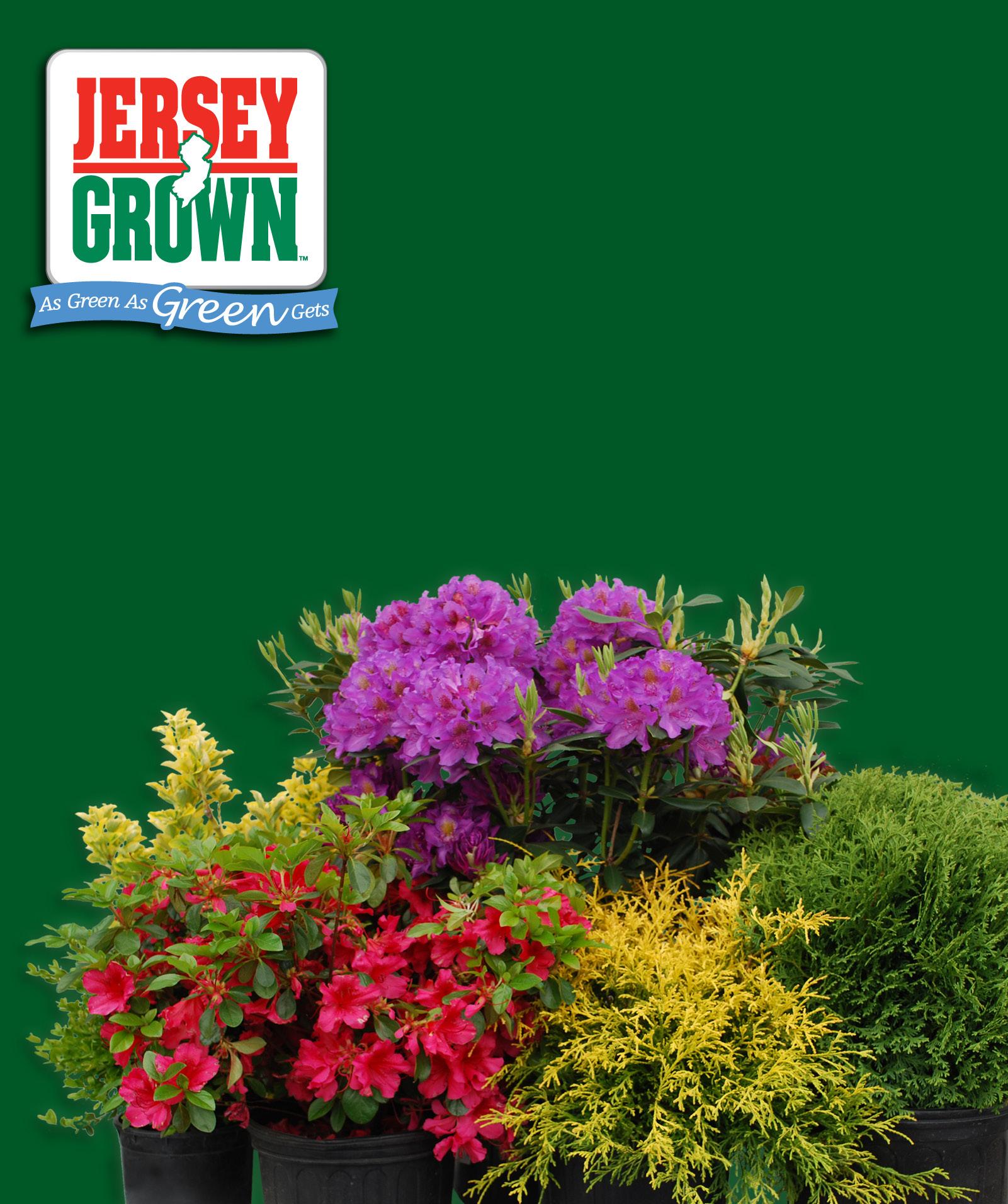







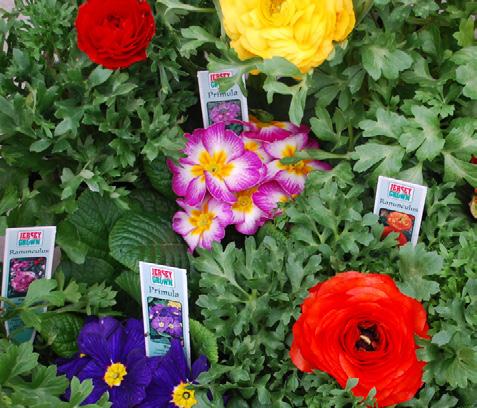





New Jersey State Board of Agri
Gloucester County farm operator Joel Viereck was sworn into his term on the New Jersey State Board of Agriculture during the Board’s July 2024 monthly meeting. The session also included an officer reorganization where Cumberland County’s Bob Blew was elected president and Burlington County’s Lisa Specca as vice president.
Viereck, who is representing the vegetable industry, has served as President of the Vegetable Growers Association of New Jersey, Vice President of the Gloucester County Board of Agriculture, and the Gloucester County Director for the New Jersey Farm Bureau.
“Joel’s vast experience as a vegetable grower and his service with the Vegetable Growers Association of New Jersey, on the Gloucester County Board of Agriculture, and with New Jersey Farm Bureau will prove invaluable in his term on the State Board of Agriculture,” New Jersey Secretary of Agriculture Ed Wengryn said. “His first-hand knowledge of the on-farm experience and the issues that farmers face will allow him to provide insights and knowledge that can enhance our representation of the industry.”
Viereck has worked 23 years as the fourth generation

New Jersey State Senator John Burzichelli,
State Board of Agriculture as New Jersey
Viereck’s wife Brianna Viereck, look on.
of a farm that spans 600 acres in Woolwich and Logan Townships. The farm is owned by David and Larry Viereck, and operated with
Joel and Mike Viereck, who are the fourth generation. The farm was started more than 100 years ago by Leslie Viereck and continued by
Leslie Viereck Jr., who is now 97. Leslie Viereck III also works on the farm and leads their farmers market program.
Viereck Farms grows more than 50 acres of tomatoes, including just over 40 acres in high tunnels. That allows the crops to be shaded,
CELEBRATING 40 YEARS
Tom Castronovo/Photo
right, swore in Joel Viereck, left, to his term on the New Jersey
Secretary of Agriculture Ed Wengryn, second from left, and
culture Reorganization Meeting

by their grandparents, and continued with their father, Denny.
Likewise, Specca has served on the board since 2021, and with her husband Dave Specca, own and operate Specca Farms. It is a fourthgeneration family owned and operated vegetable farm. The farm markets directly to the public through a pickyour-own operation and seasonal farmers markets. Lisa Specca’s primary responsibilities include being manager of retail sales and marketing, manager of human resources, greenhouse production manager, chief financial officer, and coordinator of farm safety.
Other board members and the commodity groups they represent are Kurt Alstede, of Morris County, fruit; David DeFrange II, Hunterdon County, nursery; John Hart, Mercer County, hay and grain; Stephen V. Lee IV, Burlington County, fruit; Holly Sytsema, Sussex County, dairy.
protecting them from the heat. Vierick’s also grows sweet corn, peppers, squash, and asparagus as well as wheat, soybeans, and field corn.
Incoming President Blew has served on the board since 2023 and has been an owner/manager of Centerton Nursery for 19 years. His primary responsibilities have been product development, marketing, and digital content among other duties. Centerton Nursery is a third-generation operation that delivers more than 1,600 plant varieties to more than 900 dealers in
32 states while serving the independent garden center industry. Blew, along with siblings Donald and Amy, operate the family business that was started in 1974
The State Board of Agriculture comprises eight members who serve for four years. By law, at least four of its members must represent the top commodity groups in the state, which are nursery, vegetable, fruit, and grain. For more information, visit www. nj.gov/agriculture/about/sba.

Tom Castronovo/Photo
New Jersey Secretary of Agriculture Ed Wengryn, left; New Jersey State Board of Agriculture Vice President Lisa Specca, center; and New Jersey State Board of Agriculture President Bob Blew.







In the Chef’s Corner
By Andy Lagana Chef
Korean Beef Short Ribs with Egg Fried Rice
Hello Gardener News readers. I hope your summer has been going well. As grilling is one of my seasonal mainstays, here’s a great flavorful dish that’s easy and a crowd pleaserKorean Beef Short Ribs. In Korean, “Galbi” (rib) is a type of “gui” (grilled dish), and is very popular in that country.
You can easily make Korean BBQ at home. Making this type of BBQ may seem intimidating, but it is easy to do because it is mostly inactive cooking time with the marinade. The ribs come out delicious every time! They are so juicy and tender, and when grilled, they develop a wonderful char due to the sugar content in the marinade. While I do love cooking these ribs on the grill, you can also broil them in the oven or cook them up in a pan or cast iron skillet.
You’ll need five pounds beef short ribs - cut flanken style, one Asian pearcored and cubed, one onion - coarsely chopped, five cloves garlic, one cup soy sauce, one cup brown sugar, ¼ cup honey, ¼ cup sesame oil and black pepper to taste. Keep in mind that by nature, short ribs are a tough cut of beef. The Asian pear will break down the protein and naturally tenderize the meat. Other fruits that work in similar fashion are kiwi, pineapple and papaya. Start by placing the ribs in a large pot and covering them with cold water. Soak the ribs in the refrigerator for one hour to pull out any blood. Drain, and then
combine the Asian pear, onion and garlic in a blender. Blend the ingredients until smooth. Pour the mixture into a large bowl and stir in the soy sauce, brown sugar, honey, sesame oil, and black pepper. Add ribs to the soy mixture, turning to coat evenly. Cover the bowl and marinate in the refrigerator from eight hours to overnight.
When you’re ready to cook the ribs, preheat an outdoor grill for high heat and lightly oil the grate. Remove the ribs from the marinade and cook on the preheated grill until the meat is tender and the outside is crusty, approximately 5 - 10 minutes per side. The marinade can be discarded.
For a side dish, Korean Egg Fried Rice is ideal. Gather three cups of cooked rice, three large eggs, three to four scallions or one large Korean scallion - finely chopped (about one cup), vegetable or canola oil for frying, one tablespoon soy sauce, salt and pepper, 1/2 tablespoon sesame oil and 1/2 teaspoon sesame seeds. Start by finely chopping the scallions. Crack and beat the eggs in a bowl with chopsticks or a fork. Heat a large skillet over medium high heat with two tablespoons of oil. Add ⅔ of the scallions, and stir fry them until they turn soft and fragrant. Reduce the heat to medium low and add the eggs, gently stirring to scramble them until they are set but still a bit runny. Transfer to a plate. Turn the heat up to medium high, add two tablespoons of oil
and stir in the remaining scallions until they turn soft and fragrant. Stir in one tablespoon of soy sauce. Add the rice and fry it, stirring it well and breaking up the clumps until it is well toasted. Return the eggs to the pan and mix them well with the rice, breaking them up. Add salt and pepper to taste, sesame oil and sesame seeds.
Another good accompaniment with the ribs is kimchi. The sweet, savory and crunchy bite of kimchi complements the sweet and savory marinade of the ribs. You can serve kimchi in a lettuce wrap with the short ribs or alongside the rice with cucumber slices. Green bean salad with feta is also a good and nutritious choice.
For your wine pairing, Korean beef short ribs pair well with wines that are not too sweet, fruity, oaky or tannic. Full-bodied wines with enough acidity to refresh your palate also work well with this fatty cut of meat. Some white wine options to consider are a crisp Sauvignon Blanc, off-dry Pinot Gris, Chenin Blanc from the Loire Valley in France, or a light and dry Riesling. For reds, California Zinfandel, Argentinian Malbec, Primitivo, Alentejo, Grenache-based blends from the Southern Rhone, Provence, and the Languedoc, Barbera from northern Italy’s Piemonte region or Lambrusco are ideal. A Gewurztraminer will work well also. Invite your family and friends over, and enjoy!




RUTGERS NJAES/RCE
Rutgers Cooperative Extension
Phone Directory
Atlantic County
Phone: 609-625-0056
Bergen County Phone: 201-336-6780
Burlington County Phone: 609-265-5050
Camden County Phone: 856 216 7130
Cape May County Phone: 609-465-5115
Cumberland County Phone: 856-451-2800
Essex County Phone: 973-228-2210
Gloucester County Phone: 856-224-8040
Hudson County Phone: 201-915-1399
Hunterdon County Phone: 908-788-1339
Mercer County Phone: 609-989-6830

Middlesex County Phone: 732-398-5260
Monmouth County Phone: 732-431-7260
Morris County Phone: 973-285-8300
Ocean County Phone:732-349-1246
Passaic County Phone: 973-305-5740
Salem County Phone: 856-769-0090
Somerset County Phone: 908-526-6293
Sussex County Phone: 973-948-3040
Union County Phone: 908-654-9854
Warren County Phone: 908-475-6505


Provided by Brian Schilling Director
Quick Fall Tips for a Greener Lawn
Your lawn isn’t just a patch of grass! This outdoor space is often where you and your family enjoy nature and engage in fun activities. Whether it is where kids unleash their infinite energy or friends enjoy barbecues, a properly managed lawn provides a beautiful, safe, and functional space for all.
Keeping your lawn in top shape takes effort. However, some basic practices can lead to a healthy lawn, keep potential diseases at bay, and help your lawn provide the beauty and function that you are looking for. Fall is the time to implement a few important lawn maintenance best practices.
With New Jersey’s climate, there are many common lawn diseases that can cause damage and eventually lead to bare ground in lawns. Diseases such as dollar spot, brown patch, and gray leaf spot are just a few. Although most turfgrass diseases commence mid-spring and start winding down around this time of the year, lawn care in the fall is critical for long-term turfgrass health and disease prevention. Heathy grass is the best defense against diseases and fall is the prime time for most turfgrass species to grow and build up their strength for the next season.
Fertilizing is greatly needed when temperatures cool off and grasses are actively growing. Different turf species have different nutrient requirements but nitrogen, about 1.5 pound per 1,000 sq ft per year is appropriate in most cases. On the fertilizer labels, nitrogen is the first of the three nutrient numbers. For example, 24-4-12 indicates this fertilizer contains 24% of nitrogen.
A common mistake homeowners make is thinking that more fertilizer is more food and would therefore be a good
thing for plants. However, more is not better when it comes to fertilizer for lawns, and it is not advisable to exceed three pounds of nitrogen annually. Excessive nitrogen can even promote some diseases. Follow directions on all fertilizer to avoid feeding diseases rather than happy turf.
The best way to determine how much fertilizer and other soil amendments are needed is to send a soil sample to the Rutgers soil testing lab. You will receive a detailed report with recommendations. If you need help interpreting the results, contact the Helpline at your local County Extension office for personalized assistance.
Fall irrigation promotes root growth through deep watering, but less frequency instead of the shallow and frequent watering favored in summer for turf health. This method of irrigation drives roots deeper into the ground, which, in turn, helps alleviate root disease and prepares the lawn for winter dormancy. Less frequent watering avoids wet leaves and thatch in fall’s moderate weather, which can invite foliar diseases.
If you plan to overseed this fall to fix divots or simply want to thicken your lawn, choosing the right seeds is important and will save you a lot of headaches later. Seed species and cultivar composition make all the difference as different species have different growth characteristics. Perennial ryegrass, for example, germinates rapidly, providing a quick solution for bare areas while established Kentucky bluegrass has the divot-filling capability needed to repair high traffic area damage. However, these two species generally require more maintenance and are usually more susceptible to diseases compared to tall fescue. Instead, try tall fescue, which
tolerates environmental and pest stresses well in New Jersey’s climate.
Consult your county extension agent for more specific lawn management advice or follow the Rutgers Turf Blog managed by the Rutgers Center for Turfgrass Science. Sometimes the environment is so conducive to diseases that they will show up despite your best efforts. To tackle your specific disease problem correctly, you need to know what disease you are dealing with. This is when Rutgers Plant Diagnostic Lab is here to help you figure out the problem. In addition to disease diagnosis, the lab can help you identify other pests or plant stresses as well as provide action recommendations.
Rutgers Center for Turfgrass Science is the largest of its kind in the U.S. The center generates and disseminates knowledge and provides training and education in the turfgrass sciences by fostering nationally recognized multidisciplinary research, undergraduate, graduate, and continuing professional education, and service programs that support the turfgrass industry. The Center conducts annual research symposia, field days, workshops, webinars, and educational seminars. Visit https:// turf.rutgers.edu/ for more information.
Turfgrass is a key element of public gardens, sports fields, botanical gardens, golf courses, business establishments, government and school buildings, private residences, and roadsides and right-of-ways. Turfgrasses cover more land area in the United States than any other agricultural crop. Thus, there are many diverse career options in the turfgrass and landscape industry.
LAND-GRANT UNIVERSITY NEWS RUTGERS
Open Houses Explore Marine Science in Your Backyard on September 21
The amazing world of marine science will be opened up to the public in two locations when the Rutgers University Marine Field Station (RUMFS) and the Jacques Cousteau National Estuarine Research Reserve (JC NERR) each host an Open House on September 21, from 10 a.m. to 3 p.m.
For more than 50 years, researchers have been sampling and observing the marine and estuarine environments of Little Egg Harbor and the Great Bay. Their data paint a picture of a shifting and changing system, illustrating not only the impacts of a dynamic climate but also the vital role these critical habitats play.
Surrounded by salt marsh and poised at the mouth of an active ocean inlet, data collected here is used to inform coastal fisheries, decision-makers, and our local communities about the ways in which our coastal environment is adapting.
Visitors will have the opportunity to meet Rutgers and JC NERR scientists and explore the exciting research in the Mullica RiverGreat Bay estuary and beyond. Among the activities are interactive booths, critter touch tank, history & ecology talks, guided Grassle Marsh trail walks and several games designed
for kids.
RUMFS is a field facility of the Rutgers Department of Marine and Coastal Sciences (DMCS) and marked its 50th anniversary in 2022. It is a working lab with ongoing graduate and postdoctoral level research being conducted year-round. The station is uniquely situated across from the Little Egg Inlet in the Mullica River-Great Bay estuary, one of the most pristine estuaries on the east coast.
JC NERR is a part of the National Estuarine Research Reserve System (created by the National Oceanic and Atmospheric Administration and partnered with Rutgers University) and marked its 25th anniversary in 2022. Its mission is to improve management of New Jersey coastal environments through science, education, and stewardship. It encompasses approximately 116,000 acres in southeastern New Jersey and includes a variety of terrestrial, wetland and aquatic habitats within the Mullica River-Great Bay Estuary.
Ticket reservations are required for the RUMFS location at https:// lp.constantcontactpages.com/cu/WSjQSWc. No registration is required to visit JC NERR.
Announcement from Rachel Lyons, chair, Department of 4-H Youth Development
Please help me welcome Kendrin Dyitt to his new role as County 4-H Agent in Atlantic County, effective August 1.
Kendrin comes with a wealth of 4-H experience. For more than 16 years, he’s served as a 4-H Program Associate with the Atlantic County 4-H Program. Before coming to Rutgers Cooperative Extension, Kendrin served as a project manager and an environmental analyst.
His credentials include a master’s in public administration from Columbia University and a master’s degree in environmental science from Rutgers-Newark. Kendrin also earned a bachelor’s degree in biology and environmental studies from Lincoln University.
Kendrin is experienced in STEM programming and volunteer development. He has provided leadership of the Atlantic County 4-H program for more than five years. His previous professional and personal experiences will be a tremendous asset in his transition into this faculty role within the Department of 4-H Youth Development.
Announcement by Nicholas Polanin, chair and State ANR Program Leader
Please help me extend a warm welcome Claudia Urdanivia, who begins her career on August 1 with RCE in the Department of Agriculture and Natural Resources (ANR) as County Agent III, Assistant Professor in urban agriculture and community horticulture in Essex County. Formerly a Senior Program Coordinator with the 4-H Youth Development Department serving youth in Hudson County, Claudia brings a wealth of knowledge, expertise, and community networking to this position. She will be housed at the Newark office of Rutgers Cooperative Extension, 162 Washington Street, Newark, NJ, Room 104.
Prior to joining RCE, Claudia’s experience included City Green, Inc. in Clifton, Corbin Hill Food Project in NYC, and NY Parks Green Thumb. Claudia has a BA and Graduate Certificate from Montclair State and a master’s degree from Hunter College, CUNY. In 2020, she received the NYC Food Policy 40 Under 40 Award. Recent conference presentations included the 2022 National and 2023 NE Regional National Urban Extension Leaders (NUEL) conferences and the 2023 GreenThumbGrowTogether Annual Conference in NY.
Rutgers Doctoral Student, Jae Kerstetter, Awarded Prestigious SARE Grant
Congratulations to Jae Kerstetter, a Rutgers doctoral student on receiving a 2024 Northeast Sustainable Agriculture Research and Education (SARE) graduate student grant for their dissertation research.
Titled “Back to Nature: Searching for Novel Sources of Host-Plant Resistance Against Spotted-Wing Drosophila,” their project involves studying the genetic differences between wild and farmed blueberry plants in New Jersey and looking at how these differences affect the plants’ natural defenses and their interactions with insects.
A Ph.D. student at Rutgers from 2022, Jae’s overall research focus is to investigate the genetic variation among wild and domesticated blueberry populations in New Jersey. They’re working with Cesar Rodriguez-Saona, Extension Specialist, who heads the Entomology Research and Extension Program at Rutgers Marucci Blueberry and Cranberry Research and Extension Center in Chatsworth, New Jersey
Rutgers Entomology graduate students have a strong tradition of earning these USDA awards.
12 September 2024
I am writing this article after attending 25 years of these field trials. Rutgers University is a world renowned turfgrass research facility. In late July, the Rutgers Center for Turfgrass Science hosts their annual Turfgrass industry event. This takes place over two days, first at the New Brunswick Farm and the next day at the Adelphia Farm near the Jonathan Green headquarters. The Adelphi farm must be at least 200 acres.
I am in awe of the accomplishments that Rutgers has contributed to the turfgrass industry. Starting in the 1960’s, Reed Funk started cross-breeding grasses to improve lawn quality. This process is quite involved and takes a lot of time. Years can be spent trying to choose a new grass seed variety worthy of bringing to the market for lawn use.
As you enter the trial farm, you see 10-15 large “greengrass” areas with many white markers indicating the various experimental numbers for Kentucky Bluegrass, Perennial Ryegrass, and Tall and Fine
It was early spring of 1978 when my partner to this day, Don Murphy, got me a job with Tamke Tree Experts in Liberty Corner, Somerset County, New Jersey. We originally met working in a ceramic factory in Stirling, Morris County, New Jersey. When he left to begin working in trees with Tamke, he soon got me to join him there. We both immediately were hooked on tree work and here we are 46 years later, still partners owning and operating Action Tree Service, Inc. for the past 43 years.
Our first year in business in 1981 found us working out of the back of two pickup trucks with three chainsaws. We had already been selling firewood on the side and that was how we started our selfemployment. In the late 70s, gypsy moth caterpillars (“Spongy moth” has been formally adopted as the new common name for the moth species Lymantria dispar, formerly known as the gypsy moth) were extremely destructive, leaving in their wake stands of dead Oak trees. We would go into the woods to cut, split, and deliver an average of three cords per day. We integrated into our work routine any and all tree work jobs which came our way. As our exposure and name grew, so did our tree service business. Looking back on those early startup days, it is amazing the changes, challenges and innovations

Turf ‘s Up
By Todd Pretz Professional Turf Consultant
RUTGERS - Turfgrass Research Field Days
Fescues. There are also trials to test grasses for shade tolerance. This “homemade” shade area was created 25+ years ago when Reed Funk started experimenting with Pecan trees. These trees are probably 75 feet tall now and 75 trees offer a realistic shade area to trial which grass types survive the best. Some of the germplasm in these turf plots where marked Great Britain, Poland, Ireland, Australia, etc. indicating the country where the breeder traveled to select grasses. Why are they traveling the world to breed turfgrasses? Perhaps they found a “green” plant in a park in London that did not “brown-out” like others grasses around it, or a dark-green plant in the cold of the upper Michigan

peninsula area. After years of crossbreeding different collections of grasses, you hope to find a few good ones to produce and bring to the market.
Green Industry professionals including Golf, Lawn Care, Sod Farms, Landscapers, and Suppliers attend these special days. It gives a great perspective of what new and exciting grasses may come to market to make their lives easier. Rutgers breeds for uniformity, wear tolerance, disease, and insect resistant, and reduced fertilizer and water requirements. Sometimes promising varieties of grass do not yield enough when grown in large Pacific Northwest growing fields and they must
be scrapped. That’s why it still comes down to a lot of trial and breeding attempts to bring the best new grasses to the market. The perfect grass, do you think we’ll ever discover one?
I was fascinated to find they are also using drones to help in turfgrass research. The drone can map the whole research farm, and using special infrared camera lenses helps them identify heat and stress problems and possible fungal problems. This saves the research scientist a lot of time walking through thousands of plots each week. They also use AI technology, although I can’t tell you how that helps. It’s way above my pay scale!
These research centers also
Tree Notes
By Bert Kuhn
NJ Licensed Tree Expert (LTE) Licensed Tree Care Operator (LTCO)
Proud to be an Arborist
which have occurred since. It took us a year before we were able to purchase our first chipper. Up until that time, we would stack brush in our trucks incredibly efficiently, as this was our only means by which to remove the brush debris. The chipper was a huge advancement for us, however it took some time before we purchased a dump truck. Until we did, all of the chips had to be pitchforked out of the truck by hand. Wow! I’m getting tired just reflecting upon those early days.
Thankfully, as our business grew so did our resources, allowing us to continually make modest equipment upgrades. This equated to reducing the manual nature of our work, to a degree, which in turn has led to greater longevity in this tough line of work. Our love and passion for working with trees has continued to fuel us to this day!
In those early years, everything was climbed as bucket trucks were
not common. Our early climbing techniques would be deemed unsafe by today’s standards. We were taught to free climb to the top of the tree, tie in, and descend to perform our aerial work. Today’s standard is to be secured into the tree with an approved rope and climbing gear before ascending. This is achieved using a throw line (a very small diameter cordage with weights attached) to then place approved climbing ropes aloft. Employing the throw line was a major advancement in tree climbing and became a game changer.
Being totally immersed in and continually busy operating our small tree business did not leave much time, energy, or exposure to advancements occurring. The rare times we would get out of our “bubble” came in the form of climbing competitions. Here new techniques and equipment were being employed and displayed. Having taken a 15-year hiatus from
do trials on weeds, insects, and fungus. They can use existing active ingredients or perhaps they can trial some new herbicide to see how it controls dandelions, crabgrass, clovers and more. It is really cool to see three foot wide by ten feet deep trials replicated three times to see how well dandelion or clover or other weeds react to recent applications of weed killers. This research is the key to helping the Green Industry bring new products to market to make your lawn care easier and better. While there are other turfgrass breeding universities around the globe, my hat goes off to the Rutgers Research team’s effort to bring the best in grass to the world. Dr. James Murphy, Dr. Stacy Bonos and their team are topnotch. Congratulations!
Editor’s Note: Todd Pretz is Vice President of Jonathan Green, a leading supplier of lawn and garden products in the northeast. For more information, please visit: www.jonathangreen.com
these stressors and rebound.
climbing competitions, due to what I felt was poor judging, really set me back. When I did return to the climbing competition scene in 2001, it really breathed life into my career as there were now new techniques to master. Today’s arborists tend to be more engaged, in large part due to Continuing Education Units (CEUs) being required to maintain certifications and licenses. Throughout our careers, we have experienced numerous natural occurrences which have affected trees adversely, and they seem to continue. Of major significance; the spongy moth outbreaks, the dogwood anthracnose, hemlock woolly adelgid, emerald ash borer, and severe storms (Sandy in particular). The beech is currently affected by beech leaf disease which is yet another destructive pandemic. It leaves one to hope and pray that somehow, someway these species being affected will be relieved of
Planting of trees is an incredibly important step in offsetting those losses. It is always preferable to choose native, proven hardy species, especially when replanting natural wooded buffers and corridors. There are many native trees available, which are proven hardy in our region. Plant communities worldwide experience continual changes, those which thrive do so for good reason, proving resiliency amid changing conditions. Non-natives should be considered for tree choices in towns and cities. Seek advice and assistance from arborists, landscape designers, nurserymen, or your local cooperative extension offices if you’re wondering what to plant.
They say the only constant in life is change. My career as a tree climber/worker is testament to that. One fact which remains the same is I’ve always been proud to be a New Jersey Arborist!
Editor’s Note: Bert Kuhn is President of the New Jersey Chapter of the International Society of Arboriculture and CO/Owner of Action Tree Service (# NJTC768009), based out of Watchung, NJ. He can be reached at 908756-4100






































































































































































































































































































































































































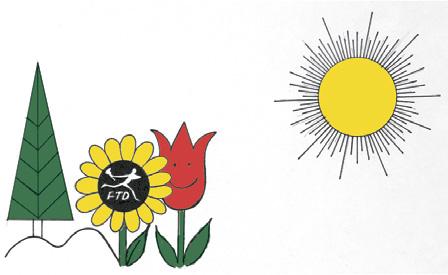

SERVING YOUR GARDENING NEEDS FOR 6 GENERATIONS
OUR EXPERIENCED STAFF CAN ANSWER YOUR GARDENING QUESTIONS AND PROVIDE GROWING TIPS
Jersey Fresh Produce at Condurso’s
Corn, Tomatoes, Squash and More Peaches are ready, Yellow and White You can buy them by the box, basket or pound
Fresh Baked Pies, Donuts, Cookies Local Honey
Homemade Ice Cream to top off your Favorite Desserts
Cold Hardy Vegetable Plants Perennials Shrubs Mums
Top Soil Mulch Bagged and Bulk
We Fill Your Own Propane Tank (No Swapping) We Also Fill RV’s and Larger Tanks 7 Days a Week
Mon. - Sat. 7-6
Sunday 7-5

As a Family Owned Business for almost 100 years, we’re Dedicated to Providing the Personal Service and Expertise that’s too often Missing in the Big Box Stores





Bobcat® E35 (25hp) Compact Excavator

This zero-tail-swing excavator provides unrestricted rotation, giving operators more room to work in close proximity to walls and other
The 3-ton compact excavator market is highly competitive with a high retail volume. R2-Series compact excavators are designed to excel in this marketplace by providing the performance, durability, quality and versatility necessary to push operator productivity and profitability to the next level.
Lease for as low as $765 per month


September 2024
The New Jersey Landscape Contractors Association (NJLCA) isthrilledtoannouncethesuccessful completion of our second summer outdoor show at County College of Morris (fourth of the event).
The New Jersey Contractors Showcase Expo (NJCSE) was an electrifying event, filled with energy, enthusiasm, and a true sense of community. Attendees had a fantastic time, despite the intermittent rain showers that graced us throughout the day. Nearly 450 determined outdoor living industry professionals braved the unpredictable weather to come together for what turned out to be an exceptional and memorable event!
Attendees had the unique opportunity to engage with a diverse array of exhibitors representing the vast outdoor living industry. From paver manufacturers showcasing their latest innovations to material suppliers providing the essentials for any landscaping project, NJCSE had something for everyone. Visitors were treated to the sight of stunning plant materials from local nurseries. Insurance professionals were on hand to offer expert advice on the best commercial insurance options available, while tool manufacturers displayed the latest tools designed to increase efficiency and productivity. The expo also featured mulch suppliers, stone providers, power

The NJLCA Today
By Gail Woolcott Executive Director
Rain Didn’t Dampen the Spirit of NJLCA’s Outdoor Summer Show
washing equipment, cutting-edge battery-powered tools, the newest models of mowers, and exquisite Corten steel outdoor décor, among many other products and services.
One of the highlights of the event was the demo area, which proved to be a major crowdpleaser! Attendees had the thrilling experience of going up nearly 85 feet in a remote-operated manlift and participating in a fun and competitive challenge to see who could achieve the fastest time putting tires on a cross using an excavator. The demo area was buzzing with excitement as visitors marveled at the power of huge log splitter attachments that sliced through logs with ease, tried out both large and small batterypowered equipment, rode mowers, and tested their skills on track loaders. The air was filled with cheers and laughter as people, whether first-timers or seasoned users, tried out the equipment. A special shoutout goes to Bobcat
of North Jersey for sponsoring the demo area and making it an outstanding feature year after year!
Lunchtime was a hit, with NJLCA Board Members stepping up to man the grills and serve over 300 hamburgers and hotdogs (each)! In addition, attendees enjoyed 6-foot hoagies and a variety of drinks provided by one of our generous food sponsors, Heritage. Free bags, courtesy of sponsor Al D. Landscaping, were also handed out to guests. The NJLCA booth was buzzing all day long as attendees spun the wheel to win a range of exciting prizes, from keychains to hats, shirts to engraved multi-tools, and even free six-month memberships. We cannot express enough gratitude to all our sponsors and vendors. Despite the downpours the night before and the drizzles on the morning of the event, everyone showed up with a smile, ready to make the best of the day. A special thanks goes
out to the NJLCA chefs—Joe Bolognese, Kevin Dulio (who also assisted in site preparation), and Adam Reisboard—for cooking up a storm (pun intended) and providing a fantastic lunch spread. And of course, we extend our deepest appreciation to the attendees who joined us, engaging with our exhibitors, and making the event such a success, despite the weather, which ultimately turned out to be not so bad after all.
Looking ahead, we’re already buzzing with ideas for next year’s show, which we can’t wait to share with you. But first, we have some exciting events on the horizon! On September 12th, we’ll be hosting a facility tour and our September Member Meeting at Borst Landscape. Then, on October 9th, get ready for our annual Golf Challenge! And shortly after that, we’ll be celebrating at our Annual Bobcat Member Meeting, followed by our highly anticipated
Holiday Gala and Landscape Achievement Awards Dinner. At NJLCA, we never slow down. Our mission is to continue educating and supporting the landscape, hardscape, and outdoor living industry while ensuring that our members and participants have a great time along the way!
Editor’s Note: Gail Woolcott is the Executive Director for the New Jersey Landscape Contractors Association. Gail received the New York State Turf & Landscape Association 2022 “Person of the Year” award on December 1, 2022. Gail also received a proclamation from the Westchester County, New York Board of Legislators proclaiming December 1, 2022 as “Gail Woolcott Day” in Westchester County. Gail has also been presented with a community service award from the Borough of Fairview, New Jersey for her assistance in leading the 9-11 Memorial Park project and the Legislative Champion of the Year award from the Federation of Employers and Workers of America. She can be reached at 201-703-3600 or by emailing gwoolcott@ njlca.org.

Tom Castronovo/Photo
Pat Barckett, director of sales and marketing at Bobcat of North Jersey in Totowa, NJ, operates an E48 Excavator in the Bobcat of North Jersey’s demonstration booth.

Bob


Rawn

Tom Castronovo/Photo Bob Kaufman, director of sales distribution at the Storr Tractor Company in Branchburg, NJ, stands on a Toro MULCH FORCE machine during the show.
Tom Castronovo/Photo
Pedatella, owner of Kodiak Landscape Design in Haskell, NJ, looks over the new paving stones display in the Braen Supply booth.
Tom Castronovo/Photo
Leegwater, left, owner of NY-NJ Trailer Supply in Butler, NJ, and Gail Woolcott, executive director of the NJLCA, chat in the NY-NJ Trailer booth.





Everyone has their favorite seasonal foods. Whether it is sweet corn in summer, fresh picked apples in the fall, or even eggnog around Christmas, everyone has their “must have” or favorite seasonal food items. For me, my go-to seasonal foods are the ones that are so much better than their out of season replacements. Sure, today, almost every produce item is available in some form throughout the year. But the ones I really enjoy are those that are so much better than their out-of-season counterparts that they shouldn’t even go by the same name.
There is nothing that says “Spring” like the first asparagus of the season. After a long cold winter, asparagus is one of the first crops to appear here in New Jersey. After a few hot days and some relatively warm nights, the first spears start to emerge from the soil. And as the weather warms up, asparagus grows faster and faster. So, from late April into June, we are honored by the presence of asparagus that can be harvested, cooked and eaten within the span of just a few hours! Nothing against the asparagus that is available
When I first began to study plants, I would routinely visit various public gardens to glean whatever knowledge possible. Longwood Gardens was a frequent destination, and I became intrigued by a short, shrubby ‘Maple’ growing adjacent to a large clump of Bottlebrush Buckeye. It turned out not to be a Maple at all but, an herbaceous plant named Yellow Wax Bells or Kirengeshoma palmata. This is a ‘Maple’ more gardens could use!
Kirengeshoma is a member of the Hydrangeaceae or Hydrangea Family and consists of two species. Kirengeshoma palmata is native to the large and more southern islands of Shikoku and Kyushu of Japan, where they grow in moist forested valleys at elevations of 2,000-6,000 feet. The genus and species names were first penned in 1890 by the Japanese botanist Ryôkichi Yatabe (1851-1899). The genus name is from the Japanese Ki for yellow and Rengeshōma or Renge Shoma in reference to Anemonopsis macrophylla, known in English as False Anemone. False Anemone appears much like a fall blooming pink daffodil, but the central trumpet displays curving and overlapping flower petals similar

The Town Farmer
By Peter Melick Agricultural Producer
Seasonal Favorites
to us during the rest of the year, but fresh picked asparagus is head and shoulders better than asparagus that is shipped in here when our locally grown asparagus is not available. One of my favorite seasonal foods would have to be tomatoes. It is hard to beat the culinary excellence of a vine ripened New Jersey tomato. During tomato season, I often eat tomatoes with every meal. For breakfast, I usually have some rye toast with a little cream cheese and one of our home-grown freshly sliced tomatoes. (I even bring my own tomato to the place where we eat breakfast every morning).
For lunch, it is usually some type of sandwich, but always with some sliced tomato on

it. And for dinner, whether it’s a salad with tomatoes or pasta with fresh tomatoes, or just sliced tomatoes with a splash of balsamic vinegar and some coarse sea salt as an accompaniment, during tomato season, vine ripened tomatoes are a must have at every meal.
I am convinced that out-ofseason tomatoes can never be referred to as good. The best compliment they can receive is that they are not as bad as they could be. Sure, I get it, tomatoes have become a yearround staple on sandwiches and in salads. People have come to expect them on everything from burgers to baguettes. But what do they add, other than some pink color and some mealy tasteless texture? The tomatoes
need to be hard enough to withstand the rigors of being shipped thousands of miles. They also must be able to hold their shape after they are put through a slicer. (Try doing that with a ripe New Jersey tomato and see what happens!)
Another peeve of mine is that many stores and restaurants store their tomatoes in refrigeration. While this might lengthen their shelf-life somewhat, it causes them to become mealy and to lose flavor. Tomatoes should never be stored at temperatures under 55 degrees. In fact, that is why some late season tomatoes here in New Jersey are not as flavorful as those that are grown during the heat of the summer. The night-time temperatures are just too low late in the fall
Morris County Park Commission
By Bruce Crawford Horticultural Manager
An Herbaceous ‘Maple’ for the Shade Garden
to Yellow Wax Bells. Hence, the name Kirengeshoma describes a plant with a yellow flower similar to the trumpet of False Anemone. The species epithet of palmata is Latin for ‘hand-shaped’ and describes how the leaf resembles the palm and fingers of a hand. Maple trees also share this leaf shape which is why I was initially fooled!
In fact, it is probably this bold Maple-like foliage that gardeners find most alluring for the shade garden. The oppositely arranged leaves can grow close to 8” in diameter and considering the plant can reach 3-4’ tall by equal or slightly greater widths, the plant clearly creates large masses of wonderfully bold texture. In fact, some plants at Frelinghuysen Arboretum annually stretch to 5’ tall and wide! Despite its size,
the stems of the plant are solid and resist bending or breaking, eliminating any need for staking. Enhancing the bold leaf texture is the attractive dark purple petioles of the uppermost leaves and the purple color of the upper third of the stem. The flower buds begin to appear in early June at the apical tips and in the leaf axils of the upper two or three tiers of foliage. The flower buds are initially round but, as the yellow petals elongate, a bell-shaped bloom forms inspiring the common name of Yellow Wax Bells.
Although the globe shaped flower buds appear in early June, the flowers do not begin to emerge until early August. Fortunately, the gardener’s patience is rewarded by a long flowering season lasting through mid-September. The flowers are rather curious since
for optimally flavored tomatoes. If you really want to enjoy great tasting tomatoes throughout the year, try canning some tomato sauce. This way, the tomatoes can be harvested when they are at their peak maturity and their flavor holds up quite well as long as they are preserved properly. But aside from that, the best thing that you can do is to try and get your fill of them while they are in season and at their peak in terms of their flavor and freshness. It’s going to be a long winter so enjoy them while you can!
Editor’s Note: Peter Melick is co-owner of Melick’s Town Farm in Oldwick and a 10th-generation New Jersey farmer. Peter is a member of the Tewksbury Township Committee, Hunterdon County, NJ. He also served as a director for the New Jersey Farm Bureau and is a past president of the New Jersey State Board of Agriculture. Peter has also been featured on NJN, News 12 New Jersey and on the Fox Business Network.
the flowers are outwardly oriented with recurved petals, providing a more dramatic appearance. The flowers also appear a week earlier than its cousin.
they never fully open. Rather, they dangle downward, appearing like small golden lanterns. When studied closely, the five flower petals overlap their neighboring petal by roughly half, tightly encircling the 15 stamens and the three central styles. By November, the seed capsule has expanded to ½” in diameter and bears the appearance of an alien creature with the three wavy and dark purple styles still attached. Following frost, the seed capsule splits open to release the small winged, tan seeds. Despite the numerous seeds produced, I have only seen the occasional seedling!
Kirengeshoma koreana is the second species. A native of Korea as the species epithet belies, the two species appear virtually identical barring the shape of the flowers! Instead of a dangling bell,
Both species prefer moist, humus rich acidic soils with a pH below 6.5. Hardy in zones 5-8, the plants mix well with other shade lovers, including Maiden Hair Ferns (Adiantum pedatum), Black Mondo Grass (Ophiopogon planiscapus ‘Nigrescens’) and Soloman Seal (Polygonatum spp.).
For a novice gardener studying plants at Longwood Gardens, its tidy appearance and bold Maplelike foliage provided all the qualities necessary to make me a fan. I never understand why they featured merely one plant with the Buckeye, but I am grateful to Longwood for providing me with the introduction!
Editor’s Note: Bruce Crawford is a lover of plants since birth, is the Manager of Horticulture for the Morris County Parks Commission, and a Past President of the Garden State Gardens Consortium. He can be reached at BCrawford@ morrisparks.net
Indian tobacco, Lobelia inflata, was chewed and smoked by indigenous North Americans as a ceremonial medicine and used as an emetic, and to treat muscle, respiratory, and skin disorders. This native plant was also burned to drive away gnats and used to counteract diseases produced by witchcraft.
Later 19th Century American doctors used lobelia to induce vomiting to cleanse the body of toxins. For a time, Indian tobacco was used as an aid to stop smoking. However, in 1933 the FDA prohibited its use on the grounds that it was ineffective.
Currently Indian tobacco is sometimes used to clear mucus from the respiratory tract and some herbalists use it to treat asthma.
Lobelias have over a dozen potent chemicals of which lobeline is the most common alkaloid. Lobeline has been shown to cause constriction and relaxation of the airways. It also induces coughing and helps to clear the airways. But with the development of safer and more effective agents, the use of lobelia has dropped sharply.
Lobeline also has a high affinity for nicotinic
In this season of excess, I exit the garden with armloads of plant material. At the kitchen counter I sort through the harvest. Some for eating, some for freezing, some for drying, some for canning, and some for arranging. Floral arrangements have been a part of my gardening life for decades and over that time I have used a lot of floral foam.
Invented in 1954, floral foam had no intended purpose. But its ability to absorb up to 50x its weight in water and low manufacturing cost was soon embraced by the florist industry. It was only five years ago that the first study revealing the environmental effects of floral foam was released. Since then, some new products have been introduced that are truly an “oasis from oasis.”
Floral foam is a kind of plastic called phenol-formaldehyde. A known carcinogen, it isn’t biodegradable, nor recyclable. It breaks down into microplastics which leach into the water, then get flushed down the drain when the container is emptied. From there, they enter the food chain at the lowest level and work their way up. If burnt, as flowers on a coffin are, they release harmful chemical gases. When cut, the released dust is highly toxic and carcinogenic. It

Is Indian Tobacco a Useful Medicine? The Native Plant Society of New Jersey
acetylcholine receptors in the nervous system and can stimulate and also inhibit action at these sites. Since there are many types of these receptors, this may account for the variable results found in scientific studies especially when studying people trying to stop smoking.
Lobeline has a high affinity for opioid receptors and experiments in animals suggest that lobeline may be useful in treating amphetamine abuse. However, no largescale human trials have been done on any medical use of lobelia in humans and we currently have no human data on safety or effectiveness. But it is clear that lobeline is a powerful drug and that overdoses may cause tachycardia, convulsions, coma, and death in animals and

By Hubert Ling Horticulture Chair
humans. Given this information I feel it is foolish to experiment on yourself. So, lobelia has been a useful medicinal plant, but its future usefulness is in question.
What is Indian tobacco good for? Well, it is an unusual native plant with an interesting history of human use going back centuries. Indian tobacco, Lobelia inflata, is a relatively small annual and biennial reaching 1-3 feet. The plant is named after Dr. Lobel, a 16th century Flemish botanist and physician. The entire plant may be covered with short hairs and the oval, alternate leaves are 1-2 inches in length with serrated edges and pointed on the far end. Indian tobacco generally forms small 1/3-inch flowers scattered along a short spike from July to October. Although a single
plant is rather inconspicuous if bunched together, they can make a nice showing. The flowers are typical Lobelia flowers, like cardinal flower or great blue lobelia but much smaller and pale blue. Since it is a lobelia, pollen matures inside the throat of the tubular flower and a sticky ball of pollen is pushed to the outside by the elongating stigma. Check www. awesomenativeplants.info for photos and details in cardinal flowers.
The species name for Indian tobacco, inflata, comes from the fruits which start out about 2 mm in diameter and seemingly blow up like miniature swollen pumpkins to a ‘magnificent’ 8 mm. The seeds inside are wind dispersed.
Indian tobacco is native to
The Garden Historian
By Lesley Parness Garden Educator
Go Floral Foam Free
has long carried a warning about its tendency to irritate the skin. So, what are the alternatives to floral foam?
Kenzan, aka spiky frog, pin frog or flower frog are Japanese devices for holding flowers. The word means “sword mountain.”
This flat, lead disc of varying size is studded with spiky brass pins onto which woody or herbaceous plant stems can be inserted. These are ideal for ikebana style arrangements where plant material is relatively sparse, but for the big blousy arrangements I find myself making in autumn, they are not large enough. In that case, pebbles or twigs of varying sizes can be placed at the bottom of your chosen vessel to anchor big branches. You can use floral tape or even masking tape to make a grid to cover the top of your vase and then, insert branches into the
grid. Balls of chicken wire can be squished to fit any shape container. Depending on the size and shape of your arrangement, you may want to use a combination of these methods. Have chicken wire, frogs and tape all handy so you can experiment.
US floral designer Holly Chapple has a line of eco-friendly grid-like cages called Holly Pillows. From Korea comes Floral Guppy, which is malleable and 100% recyclable. You can lift the entire arrangement up without disturbing it to refill the water with both of these devices.
Oshun Pouch is “a 100% biodegradable and home compostable stabilizing hydration mechanic with superior insertion hold.” It looks like a baggy which you poke with holes, rehydrate and use. Oshun Pouch is made of organic, 100% natural coco
Southern Canada and almost all of the Eastern US. It is often found in disturbed areas, in fields, and along roadsides in full sun or partial shade. It grows to a diminutive 6 inches in full sun in poor soil to a ‘giant’ 3 feet in rich deep soil in partial shade.
Small bees and butterflies utilize Indian tobacco, but deer and rabbits generally avoid it. Propagation is by seed. If sown early enough in summer the plants form basal rosettes and flower the next year. If sown in spring the seeds may germinate and flower the same year. The seeds require light to germinate so leave them near the surface and don’t allow them to dry out completely.
If you have adventuresome pets or children that chew on plants, you should avoid this toxic plant. But if you want an interesting plant, Indian tobacco is the one for you.
Editor’s Note: Hubert Ling is Past President of The Native Plant Society of NJ and Horticulture Chair. He can be reached at milhubling@verizon.net.
coir and starches found in corn or beet sugars. Additionally, it can be repurposed as a planting medium or as a top dressing for plants, providing weed suppression and enhancing the appearance of your garden. The pouch is offered in varying sizes which are soft and workable.
Sideau is a 100% biodegradable floral foam alternative from our flower-loving Dutch friends. It is made from spun fibers of basalt (a volcanic rock) and a sucrose-based binder. It absorbs and holds water better than traditional foam, uses no petrochemicals, and requires far less energy to produce. Increasingly popular among European florists, you see it now in almost every Amsterdam florist shop. Oasis itself has released an alternative to its own floral foamTerra Bricks, which they claim are the industry’s first compostable,
patent-pending floral media. They contain coir and “a plantbased binder.” After 70 years of manufacturing Oasis, it’s time for greater ingredient transparency. Increasingly, florists are joining the sustainable floristry movement. In 2021 The Royal Horticultural Society prohibited the use of floral foam at its events. Since then, many gardeners and garden clubs around the world have followed suit. Perhaps you too will consider these alternatives.
Editor’s Note: Lesley Parness offers a variety of presentations and workshops for garden clubs, plant societies, and horticultural gatherings. Recently retired from her position as Superintendent of Horticultural Education at the Morris County Park Commission, and with four decades of teaching environmental science and garden education, her focus now is garden history. A complete listing of her talks can be seen at lesleyparness. com and she can be reached at parness@verizon.net. This column will appear in the paper every other month.
Cooling off in an Ancient Rock Outcropping filled with Flora
(Continued from page 3)

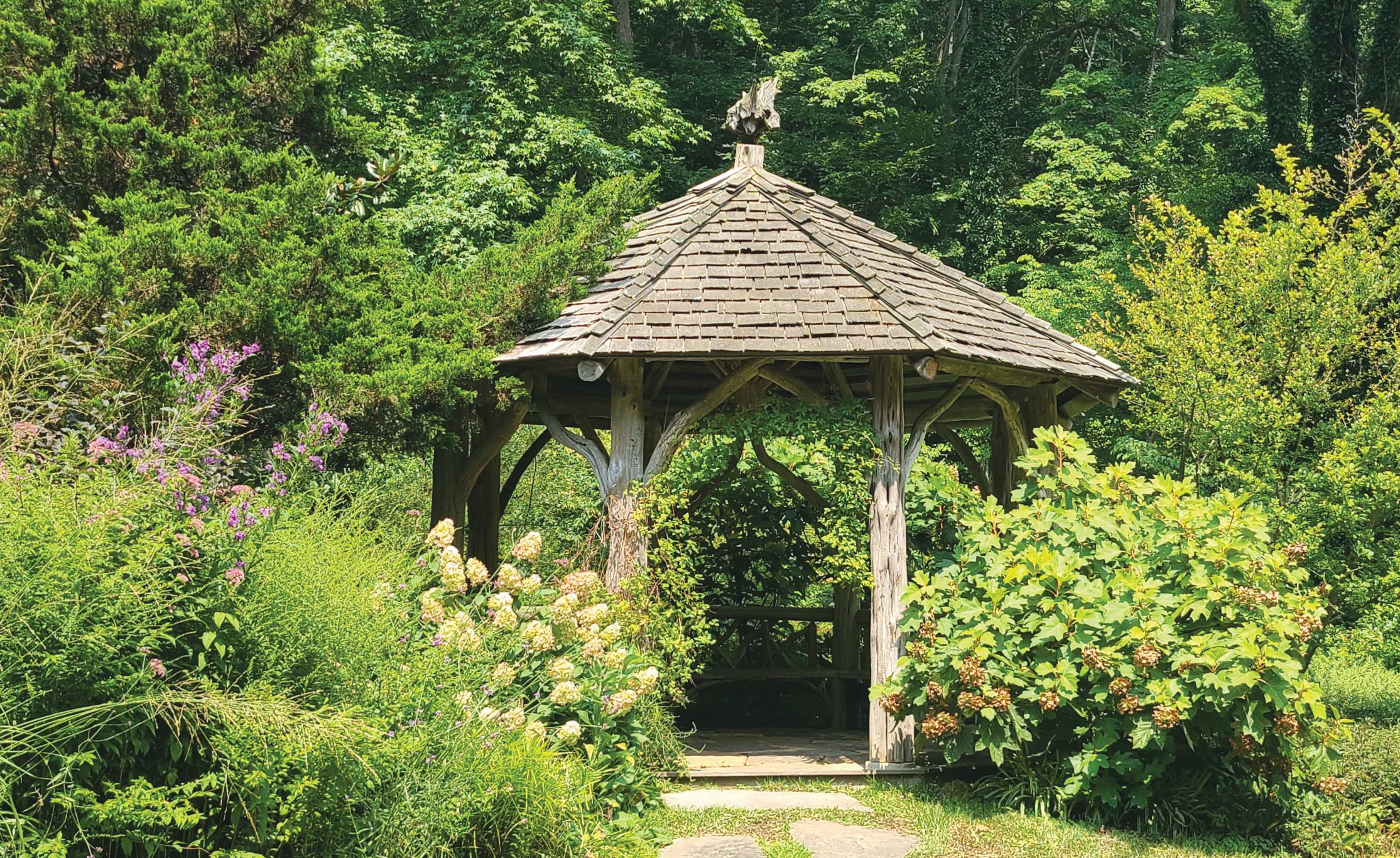
individual rock outcropping gardens between the front entrance, around the Kennel Field all the way out to the Azalea Meadow passing by the Primrose Swamp, and the Lower and Upper Ponds. I walked on the Service and the Helen R. Buck trails, and the Primrose and Epimedium paths. There are hidden staircases throughout.
I’ve also learned that the basalt rock ledges and outcroppings were born and shaped from volcanoes before the glaciers slid through.
The wooded trails connecting the rock outcroppings are lined with native wild flowers, hardy ferns, perennials and shade plants. This garden is full of horticultural interest. The garden’s peak bloom is in spring. I’ll be back!
On the surface of some of the rocks, you can almost see where ancient lava flowed. Now the flora and fauna are flourishing.
Big Rock is my favorite rock garden. It sits just below the Moggy Hollow Overlook. Right in front of Big Rock is a tiny rock garden called Bit O’ Rock.
Some of the flora that are growing on this living display rock include: Satsuki and Spider azaleas, Beardtongue, Moss phlox, Allium cernuum (known as nodding onion), Cranesbill, Balloon flower, Candytuft, Potentilla, and dwarf Norway spruce.
Another big favorite is in Kennel Field. Near the Moggy Hollow
(Cont. on Page 25)
Tom Castronovo/Photo
Rudbeckia, also known as Black-eyed Susan, a profusely blooming North American native, painting the Lower Pond’s landscape.
Tom Castronovo/Photo
A rustic gazebo situated on the valley floor of the Azalea Field, where viburnums, rhododendrons, herbs, wildflowers, magnolias and perennials complete the layers of seasonal blossoms.
NORTHEASTERN ASSOCIATION OF STATE
The Northeastern Association of State Departments of Agriculture convenes the following 10 states: Connecticut, Delaware, Maine, Massachusetts, New Hampshire, New Jersey, New York, Pennsylvania, Rhode Island, and Vermont.
PENNSYLVANIA DEPARTMENT OF AGRICULTURE
First Pennsylvania Farmworkers of the Year
Agriculture Secretary Russell Redding and Secretary of Labor & Industry Nancy A. Walker joined PA State Council of Farm Organizations President Kimberly Paley at Hollabaugh Brothers in Biglerville to recognize three frontline agriculture workers as Pennsylvania Farmworkers of the Year. Jose Mateos of Hollabaugh Brothers, Stephen “Cowboy” Kulp of Clemens Food Group in Hatfield, and Charles “Cam” Bishop of Pennsylvania Packinghouse in Washington County were honored as the first recipients of the new award.
The new awards highlight outstanding frontline farm and foodprocessing employees who work tirelessly to produce a safe, secure food supply, feeding families and local economies across Pennsylvania. The three honorees are among the 593,000-plus workers whose jobs sustain Pennsylvania’s $132.5 billion agriculture industry.
Workers eligible for the award included frontline field and livestock workers, seasonal workers, meat-packaging, and food-processing workers. Nominees were selected for their initiative, determination, and positive impact on their coworkers and their employers’ daily operations.
Photos and video of the event are at pacast.com.
CONNECTICUT DEPARTMENT OF AGRICULTURE
New One-on-One Support Available to Connecticut’s Agriculture Industry
Connecticut’s agriculture industry, including producers, food businesses, and non-profits sourcing CT Grown farm products, now have access to new one-on-one business technical assistance and grant coaching. Connecticut Department of Agriculture (CT DoAg) is utilizing funds available through the U.S. Department of Agriculture’s (USDA) Resilient Food System Infrastructure Grant Program (RFSI) to contract with three separate entities to provide an array of services, including but not limited to, market diversification and development, supply chain coordination, and business and financial planning.
“Offering these services is critical to supporting Connecticut’s agricultural community to ensure they have the tools and resources available improve the state’s food supply chain, build strong businesses, and increase the resiliency of our food system,” said Agriculture Commissioner Bryan P. Hurlburt. “By supporting supply chain coordination and technical assistance in processing, aggregation, and distribution, we are striving to increase access to expanded and improved markets for farmers.”
The three entities are CT Small Business Development Center (SBDC), Carrot Project, and New England Farmers of Color Land Trust (NEFOC). Each will have specific areas of assistance for program participants.
Agricultural producers or agribusinesses interested in working with any of the above organizations are welcome to contact them directly or reach out to Cyrena.Thibodeau@ct.gov, 860-895-3094.
NEW YORK DEPARTMENT OF AGRICULTURE
Second Round of Farmers’ Market Resiliency Program Provides Boost to Farmers’ Markets by Enhancing Infrastructure and Connections to Consumers
New York State Agriculture
Commissioner Richard A. Ball announced that nearly $250,000 has been awarded to six farmers’ market organizations across the state through Round 2 of the Farmers’ Market Resiliency Grant Program. Funding for the program was included in the 202324 New York State Budget and builds on Governor Kathy Hochul’s commitment to ensuring a resilient food system in New York State. Awards for Round 1 of the program were announced in spring 2023.
Commissioner Ball said, “The
Farmers’ Market Resiliency Grant Program continues to help our farmers’ markets by providing them the funding they need to expand online sales, improve infrastructure, and create stronger ties between New York farmers, their products, and New York consumers. Thanks to this program, we are a step closer in creating the resilient and streamlined food supply chain needed to get more New York food on the tables of all New Yorkers. I congratulate the entities that have been awarded for Round 2 and look forward to seeing the fruitful
results of their projects.”
The awarded recipients include: Cypress Hills Local Development Corporation of Kings County (New York City), Bethel Woods Center for the Arts Inc. of Sullivan County (Mid-Hudson), Webster’s Joe Obbie Farmers’ Market Inc. of Monroe County (Finger Lakes), Fulton Market Association Inc. of New York County (New York City), Village of Greenwood Lake of Orange County (Mid-Hudson), and Cornell Cooperative Extension of Oneida County (Mohawk Valley).
New York State continues to
prioritize increasing access to food for all New Yorkers through a number of efforts such as the enhanced FreshConnect Fresh2You initiative, the Farmers’ Market Nutrition Programs, the Urban Farms and Community Gardens Grants Programs, and more. Learn about the Department’s programs and initiatives focused on providing new markets for farmers, increasing food access to underserved communities, and building healthier communities at https://agriculture. ny.gov/healthy-communities
DEPARTMENTS OF AGRICULTURE NEWS
NEW JERSEY DEPARTMENT OF AGRICULTURE
State Departments Collaborate on Comprehensive Web Page for H5n1 Virus
The New Jersey Departments of Agriculture, Environmental Protection, and Health announce the creation of a comprehensive resource website to share the most up to date information on prevention and response to the H5N1 virus, a form of Highly Pathogenic Avian Influenza, in New Jersey.
The page is a collection of resources from each department addressing specific questions related to H5N1 and includes key information for agricultural and veterinary workers, healthcare providers and local health departments, and hunters. The website can be found at www.nj.gov/H5N1.
The risk of H5N1 to humans remains low and as of today, there have been no reported cases of H5N1 in humans, domestic poultry, or cattle in New Jersey. In reported cases in other states where a human tested positive, the symptoms experienced were mild.
H5N1 (known as “Highly Pathogenic Avian Influenza” or “bird flu”) is a disease caused by influenza A viruses. Wild birds, particularly waterfowl, can carry and spread these viruses but may show no signs of illness. However, H5N1 can cause severe disease in domestic poultry and dairy cattle, which may result in death. Cases of H5N1 have also been reported in wild birds, mammals, and other domestic companion animals. People with close or prolonged contact with infected animals or contaminated environments may be at a higher risk of avian influenza infection.
“This important resource page is a place where people can find a wide range of information about H5N1 and what to be aware of in various activities or situations,” NJDA Secretary Ed Wengryn said. “We want this material to be easily accessible so if there are any questions about the virus farmers and the public can have a single resource page at their disposal as needed.”
Plans are in place with Rutgers Extension offices in each county to distribute personal protection equipment (PPE) to dairy and poultry producers as needed. PPE equipment can be obtained by contacting the Rutgers Extension office in the county where it is needed.
“While the risk of bird flu to the general public remains low, it’s important to empower our residents, workers who may be at higher risk, and health care providers with information and resources needed to keep them and those they serve healthy and safe,” said Health Commissioner Dr. Kaitlan Baston. “Launching this site brings a wealth of statewide resources into one place and reflects a commitment at the state level to preparedness and response efforts.”
“With the addition of this important resource, the public now has access to multiple sources of key information that can help prevent the spread of avian influenza among wildlife and inform safety practices for hunters, bird enthusiasts, or even a homeowner placing a bird feeder in their yard,” said Environmental Protection Commissioner Shawn M. LaTourette. “It’s important the public does not touch sick or dead birds they come across and report any instances to our Fish and Wildlife hotline at 1-877-WARNDEP.”
In May, the Departments of Agriculture and Health cautioned against consumption of raw milk during the current H5N1 outbreak (read that press release at (https://bit.ly/4blYCQT). Pasteurization is proven to be the best way to get rid of harmful pathogens in milk, including influenza.
The New Jersey State Departments of Agriculture, Environmental Protection, and Health have been meeting regularly for the past several months to stay updated on the H5N1 status throughout the United States, and to stay prepared should the virus be detected in the state. Each of the departments are closely monitoring the evolving H5N1 bird flu situation and will continue to work with local, state, and federal partners to protect the health of people and animals in New Jersey.
DELAWARE DEPARTMENT OF AGRICULTURE
Scuse Honors UD’s Dr. Mark Isaacs at Delaware State Fair for Service to Agriculture
Delaware Secretary of Agriculture Michael T. Scuse surprised Dr. Mark Isaacs with the Secretary’s Award for Distinguished Service to Agriculture during the State Fair Awards presentation on Governor’s Day.
“Utilizing his vast experience in agriculture, Mark Isaacs helps teach the next generation of individuals who will be involved in agriculture—whether it’s in the field farming or researching to increase production and produce food that is more nutritious and more environmentally friendly,” said Secretary of Agriculture Michael T. Scuse.
According to Secretary Scuse, there was no better person to receive his very last Secretary’s Award than Dr. Mark Isaacs. In selecting this year’s honoree, he felt that Isaacs deserved to join the long list of people who have positively impacted Delaware agriculture through his service as a farmer, researcher, and educator.
For the past 33 years, Isaacs has served as the director of the University of Delaware’s Carvel Research and Education Center, where he oversees and directs agronomic and vegetable research and Cooperative Extension projects on more than 460 acres on the Thurman Adams Jr. Research Farm, Warrington Farm, and the Jones Hamilton Environmental Poultry Research House in Sussex County. The Carvel Research and Education Center, including the Lasher Lab, which serves as the state’s poultry diagnostic laboratory, has developed into one of the most prominent experiment stations in the country due to the strong support over the years from the state and Sussex County Council. Through these agricultural sites, Isaacs has been instrumental in ensuring that college students can benefit from work-based learning in agriculture, providing real-world skills that will make them more attractive to future employers.
In 2008, Secretary Scuse developed the Secretary’s Award for Distinguished Service to Delaware Agriculture to recognize individuals, families, and organizations who make significant contributions to Delaware’s agricultural industry.
Past recipients include Kitty Holtz (2023), Michael Parkowski (2022), Vincent Family Farms (2021), Delaware State University Department Chair Dr. Richard Barczewski, Stacey Hofmann, and Jamie Mack (2020); University of Delaware Provost Dr. Robin Morgan (2019); Fifer Orchards (2018); brothers Richard and Keith Carlisle of Greenwood (2017); former MidAtlantic Farm Credit senior vice-president Kenny Bounds (2016); Farm Service Agency official Robin Talley (2015); Schiff Farms of Harrington (2015); farmers Laura Hill of Lewes and Barbara Sapp of Milton (2014); dairy farmer Walter C. Hopkins Sr. of Lewes (2013); then U.S. Department of Agriculture Under Secretary Michael Scuse, a former Delaware secretary of agriculture (2012); Delmarva Farmer Senior Editor Bruce Hotchkiss (2012); James Baxter of Georgetown (2011); brothers David, Ed and Robert Baker of Middletown (2010); Bill Vanderwende of Bridgeville (2009); and Ed Kee of Lincoln (2008).
24 September 2024
Planting trees is one of the best things we can do for the environment. In addition to providing shade for our neighborhoods, trees are proven to be very important in stormwater mitigation because the roots of a large tree will absorb significant amounts of precipitation. Additionally, many native trees and in particular oaks like the white oak, Quercus alba and the swamp white oak, Quercus bicolor are hosts to hundreds of native birds, bees, and insects.
Early and long-term care are critical to assuring your trees have a healthy life. This spring many street trees were planted in surrounding communities. These young trees are especially vulnerable in their infancy if they don’t get watered regularly. Trees that have been planted in the last few years should be watered weekly. This can be done by putting a hose around the base of a tree and putting it on a slow trickle or by utilizing a bag-like mechanism called Treegator® where the bag gets filled with water and slowly releases moisture. Even trees that might be more established might need supplemental watering during periods of drought.
Creating a mulch circle around the base of your tree will help to conserve moisture

Pennsylvania Horticultural Society
By Andrew Bunting Vice President of Horticulture
Tree Treatment Tips
and will also provide a space so that lawnmowers and weed whips can’t damage the bark. It is important to keep the mulch away from the trunk of the tree and only add 1-2” each year. You will often see commercial properties or housing developments where the mulch has piled around the base of the tree for years creating what is called a “mulch volcano” which is very detrimental to the health of the tree. Typical types of mulch include leaf compost, hardwood bark mulch or tripleshredded bark mulch.
Young trees, especially trees that were planted as bareroot trees might need to be staked in their youth. Once a tree gets well-established the stakes should be removed. You might keep stakes in place for a few years if the young trees are vulnerable to being hit by car doors but ultimately, they need to be removed.
It many municipalities the homeowner needs to repair the sidewalk. Sometimes it is necessary to do this around the base of large trees. If this is the case, this should be done with the utmost of care. Cutting roots of trees, especially on large trees, will be very detrimental and may eventually cause the tree to go into decline. Sidewalks can be slightly shifted, or the cement can be creatively poured to “work around” these large vulnerable roots.
Some young trees might benefit from having a fourfoot-tall cage placed around the trunk. In areas where there is considerable deer pressure, a cage will help protect young and pliable trees from being rubbed by young male deer. Deer rubbing can either severely injure the tree or in some cases can damage it so significantly that it kills the tree.
There are dozens of great trees to choose from that make excellent shade trees and street trees. A good source of trees to consider for the Mid-Atlantic region is the Pennsylvania Horticultural Society’s Gold Medal Program. The following is a selection of great trees from that list to consider. The swamp white oak, Quercus bicolor as the name would imply can thrive wet conditions and is a great oak tree for urban conditions. Nyssa sylvatica Wildfire® is a selection of the sour gum noted for its pyramidal habit and its brilliant fire engine red fall color. It can also tolerate poorly drained and wet soils. Acer x freemanii Autumn Blaze® is a hybrid maple that is fast growing and has exceptional red fall color. The American hornbeam, Carpinus caroliniana is smaller in stature reaching 20-25 feet at maturity. In its native habitats
it is often found growing as an understory tree along streams. It has smooth grey bark which is attractive in the winter and yellow to orange fall color. It is often used as a small tree planted under power lines and is also promoted for urban use.
Editor’s Note: Andrew Bunting is Vice President of Horticulture for the Pennsylvania Horticultural Society. He is one of the most recognized horticulturists in the Philadelphia, Pa., region and a highly regarded colleague in the world of professional horticulture. Bunting has amassed a plethora of awards, including the American Public Gardens Association Professional Citation, Chanticleer Scholarship in Professional Development, Delaware Center for Horticulture’s Marion Marsh Award, and the Certificate of Merit from the Pennsylvania Horticultural Society. In addition, Bunting has lectured extensively throughout North America and Europe, and participated in plant expeditions throughout Asia and Africa. Learn more at https://phsonline.org/team/ andrew-bunting
Scientists Developed a Unique Approach to Conserve the Monarch Butterfly
The monarch butterfly (Danaus plexippus L.) is one of the most widely popular butterfly species in North America. We are accustomed to seeing its beautiful orange wings with black-veined outlines flying in gardens and wildflower fields during the summer season.
Can you envision the summers without the monarch butterfly? Imagine the impact on the flora and ecosystem diversity of North America if this iconic species became extinct.
To ensure this imaginative but plausible scenario can be preventable, USDA scientists at the Agricultural Research Service (ARS) Weed and Insect Biology Research Unit, in Fargo, North Dakota, developed the first known cryopreservation protocol for the successful long-term storage of monarch butterfly germplasm, specifically for preserving germ cells (spermatozoa or sperm cells). More importantly, the technique used in this protocol allows for the preserved samples to remain viable and highly intact post-cryopreservation.
“An important aspect of insect conservation is habitat conservation. Our research is a new approach to conservation through germplasm cryopreservation,”
explained Courtney Grula, a scientist at the Weed and Insect Biology Research Unit. “This study is the first to implement a technique to extract semen from the male reproductive tract in insects, a common technique used in mammals.”
The viable sperm cells can one day be used with artificial insemination to bring back this species of butterflies in the event of a population loss. Although more studies are needed to develop an artificial insemination protocol using cryopreserved sperm cells from male butterflies, the study shows that this protocol is a viable method for germplasm conservation in this and similar species. Furthermore, ARS researchers in Fargo are assessing artificial insemination techniques for female butterflies using cryopreserved sperm cells from male butterflies.
The monarch butterfly population was classified as an endangered species in North America by The International Union for Conservation of Nature. This was due to a rapid population decline that was observed from 1996 to 2014, followed by its stabilization over the past decade. Even though the current numbers are at a level of lesser concern, the decreasing trend has not stopped. Estimating the exact numbers is challenging
due to their breeding and migratory behavior, as the monarch butterfly migrates every year long distances in a multi-generational migration that extends from Mexico to Canada.
Like other pollinator species, the monarch butterfly’s survival is threatened by climate change, the loss of native plants – milkweeds – and the rapid disappearance of their habitats.
Scientists are collaborating with stakeholders to protect this species, including teaching the cryopreservation technique to researchers and breeders at the San Diego Zoo. In addition, they are working on extending the cryopreservation technique to cryopreserve spermatozoa from other endangered species, such as the Sacramento checkerspot butterfly, which is endemic to New Mexico.
Grula, Research Biologist Arun Rajamohan, and Research Leader Joseph (Joe) P. Rinehart describe the technique in a study recently published in Scientific Reports.
“For people who are interested in helping monarch populations, they can plant common milkweed [Asclepias syriaca] in their yard, as this is utilized by monarchs for egg laying and larval diet,” added Grula.


Cooling off in an Ancient Rock Outcropping filled with Flora
(Continued from page 21)

Overlook and the Lower Pond stand two majestic Dawn redwoods (Metasequoia glyptostroboides). The tallest is between 114 and 115 feet. A lightning rod was installed on the deciduous conifer several years ago to protect it.
In the 40s, some folks from the Arnold Arboretum went on expedition to China in search of this supposedly extinct species. They brought back seeds, and a few resulting seedlings were given to Mr. Buck to plant on his estate. As North America’s first public arboretum and a National Historic Landmark, the Arnold Arboretum is owned by the City of Boston and managed by Harvard University. The Arboretum was originally designed by Frederick Law Olmsted and Charles Sprague Sargent. Today its living collection has more than 15,000 plants, and it is one of the largest and best documented in the world.
Getting back on to the valley floor at Leonard J. Buck Gardens, I spotted lots of magnolias, rhododendrons and viburnums. I love how the plant communities interact with the physical environment. I also spotted a giant birdhouse.
The Moggy Brook was gently flowing by handmade rock walls and is lined with black-stemmed maidenhair fern and blue forget-me-nots.
My visit definitely cooled me off a few degrees as I traveled from the top of the gorge to the lower valley floor. I thought it was really cool to visit this geological, historical marvel again.
I also enjoyed running into
(Cont. on Page 26)

Tom Castronovo/Photo
The Moggy Brook gently flowing by hand-made rock walls on the valley floor as lily pads float on top of the water.
Tom Castronovo/Photo
One of the two prehistoric dawn redwood trees (Metasequoia glyptostroboides) overlooking the Lower Pond.
Cooling off in an Ancient Rock Outcropping filled with Flora

Tom Castronovo/Photo
Purple Martin bird house nestled amongst Joe Pye Weed, also known as Queen of the Meadow, on the outskirts of Kennel Field Meadow.
(Continued from page 25)
Leonard J. Buck Garden Supervisor Roman Fabiyan during my visit. It was great to walk and talk about the rare and beautiful plants that adorn the natural landscape and the dramatic scenery again.
By the way, in 2017 a New Jersey State Senate and Assembly Resolution proclaimed the first Friday in June each year as New Jersey Public Garden and Arboretum Day.
If you choose to visit this educational learning garden, please leave your pets at home, except for service animals.
Editor’s Note: Tom Castronovo is executive editor and publisher of Gardener News. Tom’s lifelong interest in gardening and passion for agriculture, environmental stewardship, gardening, and landscaping, led to the founding of the Gardener News, which germinated in April 2003 and continues to bloom today. He is also dedicated to providing inspiration and education to the agricultural, gardening, landscaping, nursery, and outdoor living communities through this newspaper and GardenerNews.com.

Tom Castronovo/Photo
Front entrance sign on 11 Layton Road in Far Hills, Somerset County, NJ.



Tom Castronovo
Todd Pretz
Gail Woolcott
Lesley Parness
September 2024 Columnists
Brian Schilling
Peter Melick
Bob Andrzejczak
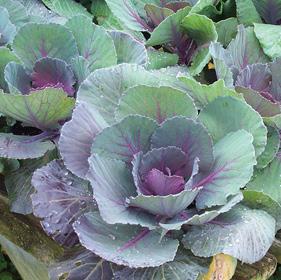


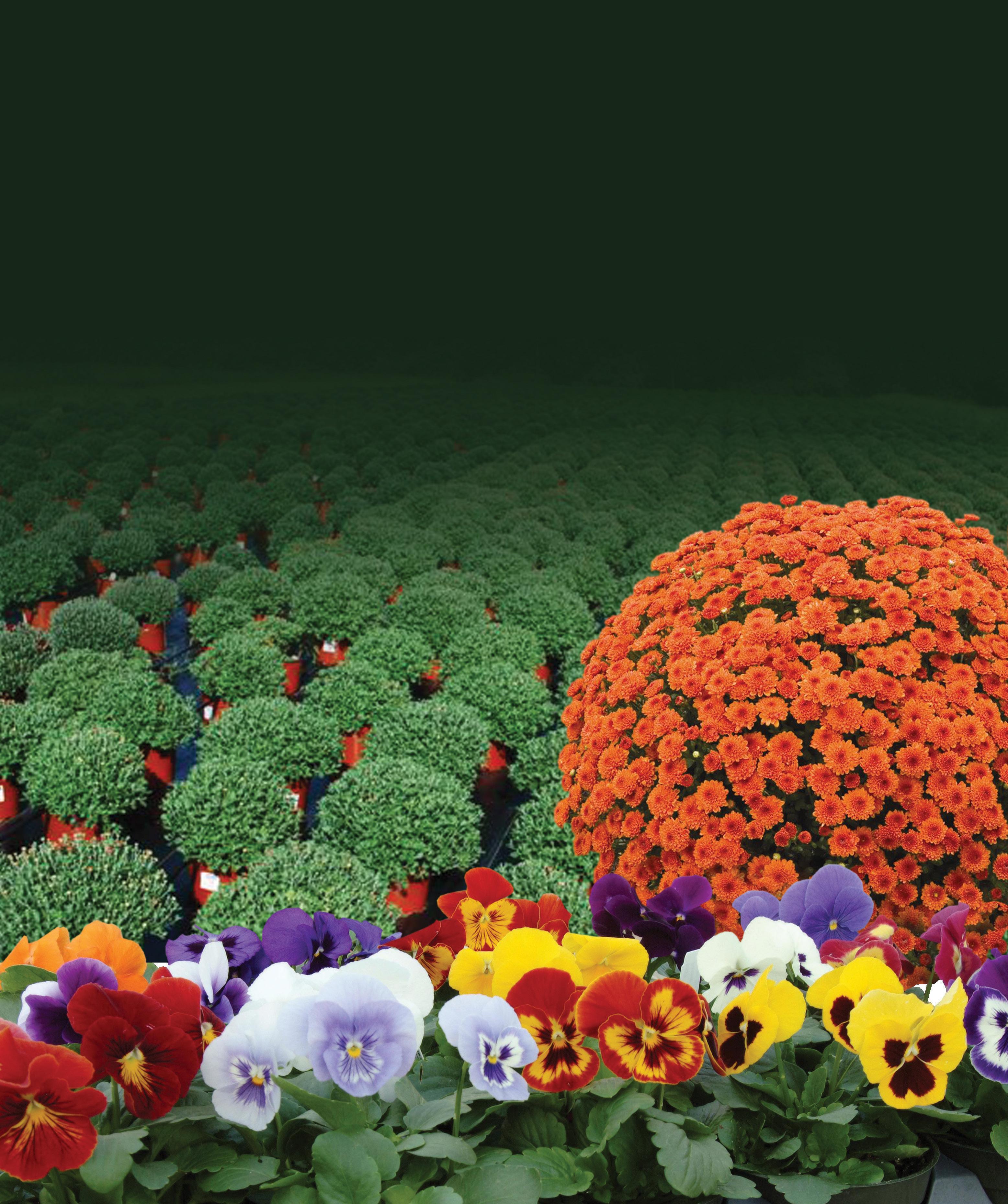




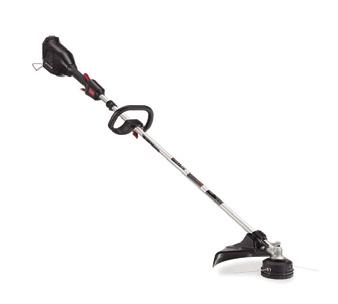



7500-G SERIES ZERO-TURN
96” TURBO FORCE ® CUTTING DECKS
PRODUCTIVITY TO A NEW LEVEL
Impressive 96” wide cutting deck folds to 75” to fit in
REVOLUTION HANDHELD PRODUCTS
ALL DAY PERFORMANCE
The fully interchangeable 60V Max*
Flex-Force battery system powers the entire line of Revolution commercial grade handheld tools. The backpack, available as a power source for the leaf blower, string and hedge trimmers, and is built for comfort and ready to keep jobs moving all day.


STAND-ON MOWERS
TRACTION & HANDLING
A wide stance and optimal balance enhance hillside stability and control.
CUSHIONED SUSPENSION
Flex-Ride operator platform suspension self-compensates for operators of all sizes, resulting in less fatigue and higher productivity throughout the day.



SPRAYMASTER®
Dual
Provide

A variety of attachments and accessories such as Mulch Dump, Pro-Force blower, snow thrower, power broom, tine rake, dethatcher and BOSS snow blade all provide the ultimate in productivity.


